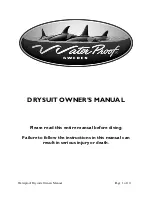
Waterproof Drysuite Owners Manual
Page 8 of 10
Adjustments of Seals
On a new suit, or one that has had new neck or wrist seals installed, the seals will most likely
need adjusting. The seals need not be uncomfortable to seal properly. They only need to be
snug against the skin for a proper fit. If you are not familiar with the proper fitting or trimming
of seals contact your drysuit dealer before cutting. If neck and/or wrists seals are too tight cut a
little (1/4 inch/6mm or less) off the end/length of the seal. Be sure to remove suit before cutting
seals. A pair of sharp regular household scissors will cut the seal easily. Latex seals are marked
with rings for cutting guides. Cut only a small amount (1/4 inch/6mm or less) at a time, then
check fitting over wrists or neck. If you cut too much you may cause a seal to leak and it will
have to be replaced.
Care of the Latex Seals
Latex seals are standard on Waterproof drysuits, neoprene seals are available as an option.
Most divers find that latex provides a dryer and more comfortable seal, however the nature of
the latex material means that more care is required than for neoprene seals and after some
time the latex seals may need to be replaced. Seal replacement is not difficult but must be done
correctly. Classes in seal replacement are offered by some dealers if you want to learn to "do it
yourself", however we recommend that you take your suit to a Waterproof dealer experienced
in drysuit repair.
You can help your seals to last by following these suggestions:
• Store the suit away form sources like Ozone and UV radiation or Sunlight.
• Rinse latex seals with fresh water and dry before storage.
• Always dust dry latex seals with unscented talc (available from your Waterproof dealer)
before storage.
• Take care not to catch the seals on sharp objects.
• Periodically wash the seals with soap and water to remove body oils that may accumulate and
cause degradation of the material.
Care of the Dry Zipper
The Dry zipper is the heart of your drysuit and it s most expensive component. With care the
zipper can last for the life of the suit. All zippers are examined and pressure tested before
leaving the factory. The drysuit zippers can only be damaged by mishandling. Please treat with
care. We can not take responsibility for zippers damaged by misuse.
• Lubricate the zipper (on the outside of the teeth only) with paraffin wax (available from your
Waterproof dealer) or beeswax, DO NOT use silicone or petroleum based lubricants.
Avoid sticky waxes, as they will tend to attract sand and grit. A very small amount of wax is
sufficient. Clean zipper with fresh water after diving being sure to remove any debris from
between zipper teeth. Dry zipper before storage. Rub wax on outside of zipper teeth after
every 4th or 5th dive and before storage. Always store folded or bagged suit with zipper open.
• When storing or transporting the suit keep the zipper unzipped. When opened the zipper is
much more flexible, when closed the zipper becomes semi-rigid and might be damaged if it is
folded, or if a heavy object were inadvertently placed on it.
• When opening and closing the zipper be sure the teeth are in alignment and that the
supporting tape is not kinked. This will normally require two hands. Take great care not to zip
undergarment material into the dry zipper, as this is the most common way the zipper gets
broken.




























